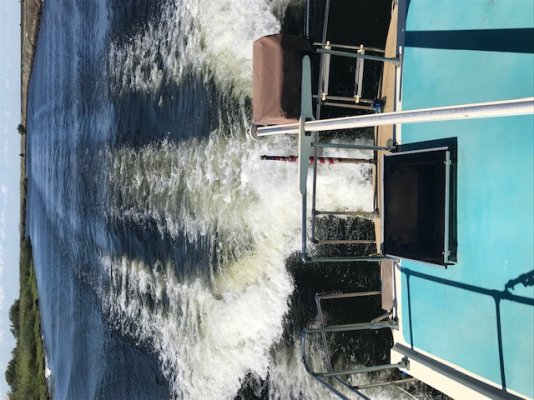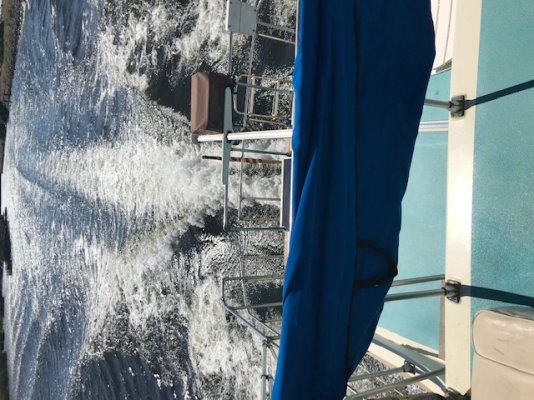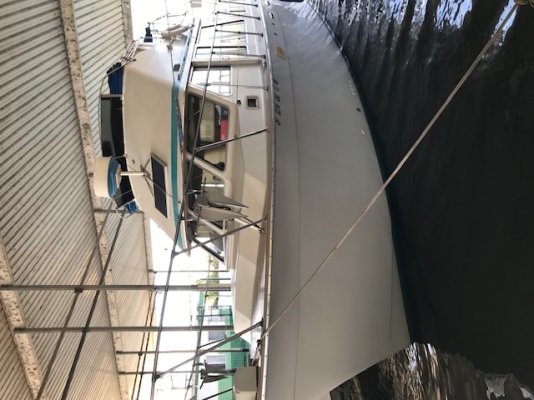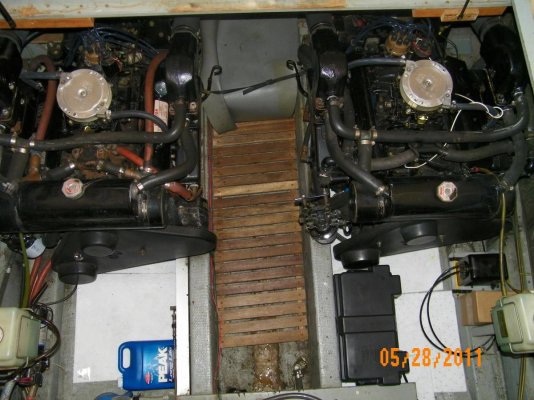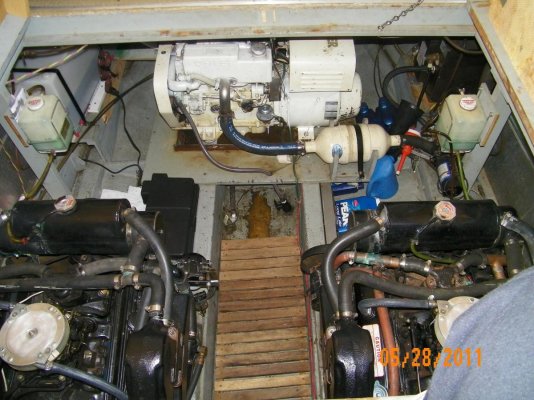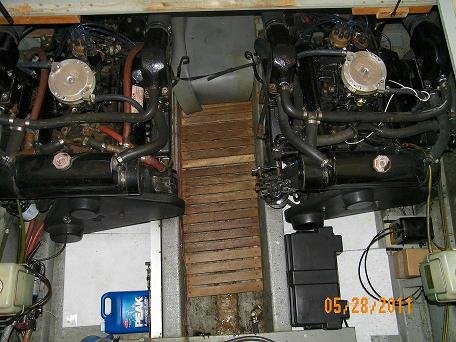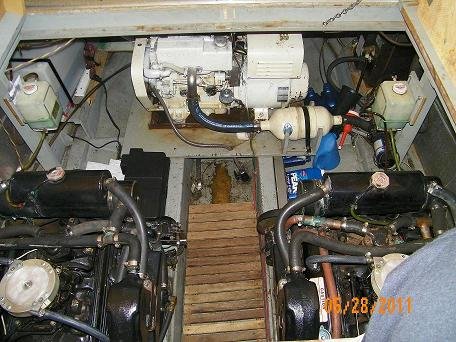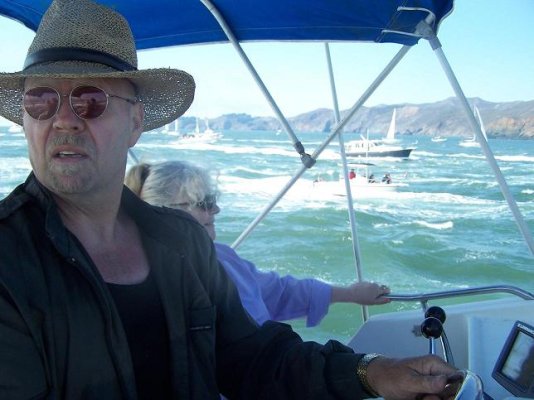So I am pretty new to all this and I am looking at the Helmsman 43E. I dont think it has a wing engine either....you guys have no concerns? I do plan to do some extended cruising and this will be my first trawler. I have done some decent sailing...but this is very new to me and I thought either twin engines or a wing engine was pretty important.
You are using an out of date browser. It may not display this or other websites correctly.
You should upgrade or use an alternative browser.
You should upgrade or use an alternative browser.
Operating Cost of Single versus Twins
- Thread starter Hydrospud
- Start date
The friendliest place on the web for anyone who enjoys boating.
If you have answers, please help by responding to the unanswered posts.
If you have answers, please help by responding to the unanswered posts.
psneeld
Guru
So I am pretty new to all this and I am looking at the Helmsman 43E. I dont think it has a wing engine either....you guys have no concerns? I do plan to do some extended cruising and this will be my first trawler. I have done some decent sailing...but this is very new to me and I thought either twin engines or a wing engine was pretty important.
Read the thread back closely....twins and wings are more desireable when self rescue might be the only out. They can be desireable for convenience too...but that is a very personal choice.
Rule number one.... dont take one or even several opinions as gospel.
BruceK
Moderator Emeritus
- Joined
- Oct 31, 2011
- Messages
- 13,347
- Vessel Name
- Sojourn
- Vessel Make
- Integrity 386
Your thinking could be a logical extension of your sailboat days, you likely had "the iron topsail",and the sails, to rely on, ie alternative propulsion.So I am pretty new to all this and I am looking at the Helmsman 43E. I dont think it has a wing engine either....you guys have no concerns? I do plan to do some extended cruising and this will be my first trawler. I have done some decent sailing...but this is very new to me and I thought either twin engines or a wing engine was pretty important.
Some here will tell you a single is more reliable than twins,it follows no engine at all would make the risk of breakdown zero.
I second your aim of alternative propulsion. Definitely important.
Simi 60
Guru
- Joined
- Jul 1, 2016
- Messages
- 5,482
- Location
- Australia
- Vessel Make
- Milkraft 60 converted timber prawn trawler
. Nothing (except possibly money) prevents you from having a twin engine, twin keeled boat with the skegs under the propellers and supporting the rudders.
Ted
Space or lack of would turn me off.
Having plenty of space around the engine means it gets regular inspection several times a day and maintenance by me.
If I had twins with limited space, it would not get regular inspection
Maintenance would have to be outsourced at great expense and likely not be done in a timely manner due to labour shortages
It would also require a marina berth to be taken for several days adding even more expense.
I like to be out, not in, outsourcing simple maintenance.
Last edited:
Question:
Have we beat this to death... it will NEVER be solved.
Wifey B: It was solved. You just missed it. For that, you have to reread every post on the forum pertaining to the subject.





Solved IT!
Planing Hull with Twins Wins!! - Baby!
Only kidding!
Just like everything about a boat... propulsion factors reach into the hundreds [even thousands] of nuances/meaningful-reasons to have things one way or another, regarding all factors of propulsion.
Similar to this truism: "Change is the only thing constant"... Regarding boats: "There's a trade-off for everything"!
Photos were taken yesterday, Friday 6/17/2022 [I and my worker had just completed a full engine service to her, exterior pressure wash too]. Filled her water 77 gal tanks and poured in $700 to fill her 200 gal gas tanks. Then; took her out for a "test" spin. [Monday we're cruising 100 miles to new docking location - that is much nearer to our home].
1st wake photo 3600 rpm. Second wake photo 4300 rpm. Didn't bother to get into the 5K + rpm range; but, you get the picture! Full boat photo [please notice her eye on forward cabin looking at you!] = priceless to us!
Sorry the photos got turned. When I punch em up on this post they straighten-up for me... hope they so the same for you all!!
Cheers! - Art


Planing Hull with Twins Wins!! - Baby!

Only kidding!
Just like everything about a boat... propulsion factors reach into the hundreds [even thousands] of nuances/meaningful-reasons to have things one way or another, regarding all factors of propulsion.
Similar to this truism: "Change is the only thing constant"... Regarding boats: "There's a trade-off for everything"!
Photos were taken yesterday, Friday 6/17/2022 [I and my worker had just completed a full engine service to her, exterior pressure wash too]. Filled her water 77 gal tanks and poured in $700 to fill her 200 gal gas tanks. Then; took her out for a "test" spin. [Monday we're cruising 100 miles to new docking location - that is much nearer to our home].
1st wake photo 3600 rpm. Second wake photo 4300 rpm. Didn't bother to get into the 5K + rpm range; but, you get the picture! Full boat photo [please notice her eye on forward cabin looking at you!] = priceless to us!
Sorry the photos got turned. When I punch em up on this post they straighten-up for me... hope they so the same for you all!!
Cheers! - Art



Attachments
Last edited:
The wifey and I have gone around and around with the twin vs single question. The answer is, it depends. Like so many boat decisions, there is not a right answer, just an answer.
The current boat design that has our attention can be had with a single or twins. The pro's and con's have already been discussed and beaten to death.
 However, with this design, twin engines with a driveline protected by skegs, allows to the boat to dry out. Being able to dry out the boat is a big deal for us and over shadows the negatives of twins.
However, with this design, twin engines with a driveline protected by skegs, allows to the boat to dry out. Being able to dry out the boat is a big deal for us and over shadows the negatives of twins.
Not all twins have a exposed props, prop shafts and rudders.
Surprisingly, I have not seen hybrid mentioned.
I have been very skeptical of hybrids on a cruising boat. A an electric motor is not going to power the boat for days and days at the speed of a diesel engine. In fact, the battery bank is likely only going to be able to power the electric motor at slow speeds for a few hours a day. Having said that, we are interesting in traveling some of the European canals which can have speed limits. Having the engine running for hours at just over idle speed, even on a single engine in a boat with twins, is not attractive. A hybrid on the other hand starts to make sense.
A hybrid as a backup for a single is also workable. It is not going to move the boat for hour after hour after hour at normal speed but it would be enough to get to a place of safety given how many boats are used.
Cost is the big question of course, but if one can use the hybrid's capabilities to replace a generator, the cost vs capabilities equation gets interesting.
Later,
Dan
The current boat design that has our attention can be had with a single or twins. The pro's and con's have already been discussed and beaten to death.

Not all twins have a exposed props, prop shafts and rudders.
Surprisingly, I have not seen hybrid mentioned.
I have been very skeptical of hybrids on a cruising boat. A an electric motor is not going to power the boat for days and days at the speed of a diesel engine. In fact, the battery bank is likely only going to be able to power the electric motor at slow speeds for a few hours a day. Having said that, we are interesting in traveling some of the European canals which can have speed limits. Having the engine running for hours at just over idle speed, even on a single engine in a boat with twins, is not attractive. A hybrid on the other hand starts to make sense.
A hybrid as a backup for a single is also workable. It is not going to move the boat for hour after hour after hour at normal speed but it would be enough to get to a place of safety given how many boats are used.
Cost is the big question of course, but if one can use the hybrid's capabilities to replace a generator, the cost vs capabilities equation gets interesting.
Later,
Dan
catalinajack
Guru
I can fully inspect the outside of my twin engines in seconds at any time. Do I have plenty of space? Nope, but I have enough. You obviously have an easily-accessed engine room. Many boaters, perhaps a large majority do not, even those with singles. In fact, there are plenty of boats, with singles, that floor hatches must be pulled and a ladder descended to get to that single engine. My guess is that it is not often done while underway. Safety issues come to mind. For that matter, I do not like entering my easily-accessed engine room while underway.Space or lack of would turn me off.
Having plenty of space around the engine means it gets regular inspection several times a day and maintenance by me.
If I had twins with limited space, it would not get regular inspection
Maintenance would have to be outsourced at great expense and likely not be done in a timely manner due to labour shortages
It would also require a marina berth to be taken for several days adding even more expense.
I like to be out, not in, outsourcing simple maintenance.
markpierce
Master and Commander
- Joined
- Sep 25, 2010
- Messages
- 12,557
- Location
- USA
- Vessel Name
- Carquinez Coot
- Vessel Make
- penultimate Seahorse Marine Coot hull #6
Most people want lots of power and speed, which equates to multiple engines. But not I.
Last edited:
Regarding engine access.
As mentioned in post # 157:
"Friday 6/17/2022 [I and my worker had just completed a full engine service to her, exterior pressure wash too].'
As my masonry, concrete and tile company's worker spent much of the day water blasting and scrubbing our Tolly's exterior... I thoroughly, comfortably checked out and serviced the twin engines and their trany.
After full service / check-out [that took about three hrs.] I gleefully sat on edge of saloon floor between two large, hinged "floor-doors" watching below and listening to the twins purr while synchronized in idle. Had an accurate temperature gun in my hand. For 30 minutes I kept pointing at all sorts of different, specific locations on each engine for comparison. Very similar temps in all areas with many reading exactly the same temperature. Shortly after that we took her out for test run and gasoline tank fill ups.
I nurture our boat's twins... they love me!! As I do them!!!



As mentioned in post # 157:
"Friday 6/17/2022 [I and my worker had just completed a full engine service to her, exterior pressure wash too].'
As my masonry, concrete and tile company's worker spent much of the day water blasting and scrubbing our Tolly's exterior... I thoroughly, comfortably checked out and serviced the twin engines and their trany.
After full service / check-out [that took about three hrs.] I gleefully sat on edge of saloon floor between two large, hinged "floor-doors" watching below and listening to the twins purr while synchronized in idle. Had an accurate temperature gun in my hand. For 30 minutes I kept pointing at all sorts of different, specific locations on each engine for comparison. Very similar temps in all areas with many reading exactly the same temperature. Shortly after that we took her out for test run and gasoline tank fill ups.
I nurture our boat's twins... they love me!! As I do them!!!



Attachments
Last edited:
Simi 60
Guru
- Joined
- Jul 1, 2016
- Messages
- 5,482
- Location
- Australia
- Vessel Make
- Milkraft 60 converted timber prawn trawler
I can fully inspect the outside of my twin engines in seconds at any time. Do I have plenty of space? Nope, but I have enough. You obviously have an easily-accessed engine room. Many boaters, perhaps a large majority do not, even those with singles. In fact, there are plenty of boats, with singles, that floor hatches must be pulled and a ladder descended to get to that single engine. My guess is that it is not often done while underway. Safety issues come to mind. For that matter, I do not like entering my easily-accessed engine room while underway.
Rejected any boat that had floor boards or ladders to access ER, didn't even look.
A walk through door, 6ft headroom and enough space to walk around engine and pull up a seat to work on the motor and minimum 3000nm range was my must have.
House sized galley and bathroom, a laundry and walk around king sized bed was hers.
Got it all and more.
Rejected any boat that had floor boards or ladders to access ER, didn't even look.
A walk through door, 6ft headroom and enough space to walk around engine and pull up a seat to work on the motor and minimum 3000nm range was my must have.
House sized galley and bathroom, a laundry and walk around king sized bed was hers.
Got it all and more.
Worthy requirements for a 24/7 365 a year liveaboard!

mvweebles
Guru
- Joined
- Mar 21, 2019
- Messages
- 7,223
- Location
- United States
- Vessel Name
- Weebles
- Vessel Make
- 1970 Willard 36 Trawler
As you can imagine, a 36-foot boat, even full displacement, that carries 400+ gallons in saddle tanks has a cramped engine room. Access was easier 25-years (and a few pounds) ago. I have worked hard to improve access and space - moved water heater to lazarette, moved the FLA batteries to the lazarette (going to LiFePO4 enabled), and reconfigured the hydraulic tank for the stabilizers. It's now barely adequately but it is adequate.I can fully inspect the outside of my twin engines in seconds at any time. Do I have plenty of space? Nope, but I have enough. You obviously have an easily-accessed engine room. Many boaters, perhaps a large majority do not, even those with singles. In fact, there are plenty of boats, with singles, that floor hatches must be pulled and a ladder descended to get to that single engine. My guess is that it is not often done while underway. Safety issues come to mind. For that matter, I do not like entering my easily-accessed engine room while underway.
The Defever 44 has an admirable engine room, especially for a twin. The engines are relatively small which helps. And access is through a proper engine room door to a near-standup engine room. But there is a cost - the DF44 is a tall boat which contributes to buyer-observations that the boat has a lot of stairs and the stairways are steep (common on many boats but more so with Defever). Much as I like the Defever 44, in my opinion, she absolutely needs active stabilization, and access to floating docks common along the west coast is difficult for docking. All boats are s tradeoff - the fabulous engine room drives some of those tradeoffs with a Defever 44.
Another route to a proper engine room in a relatively affordable veseel is Simis approach - a converted commercial vessel. While I have no knowledge of his boat, these frequently bring a whole host of compromises. Often the layout is difficult to convert (what to do with a cavernous fish hold, or pipe bunks for a dozen crew). Conversion build-quality is often fair at best with ample use of Home Depot materials. You end up with not just a custom boat, but s highly personalized custom boat. Nothing wrong with that, but unloading it down the road can be incredibly frustrating.
Peter
rslifkin
Guru
- Joined
- Aug 20, 2019
- Messages
- 7,584
- Location
- USA
- Vessel Name
- Hour Glass
- Vessel Make
- Chris Craft 381 Catalina
As far as engine room access underway goes, mine is easy enough to move around safely that I'll go down there at slow cruise to look around. I won't climb all the way outboard, but I can safely get my eyes out there. If we're running on plane I won't go down. It's extremely loud and it's just too easy to get knocked into something hot or moving.
catalinajack
Guru
Bless your heart.Rejected any boat that had floor boards or ladders to access ER, didn't even look.
A walk through door, 6ft headroom and enough space to walk around engine and pull up a seat to work on the motor and minimum 3000nm range was my must have.
House sized galley and bathroom, a laundry and walk around king sized bed was hers.
Got it all and more.
... a converted commercial vessel... these frequently bring a whole host of compromises. Often the layout is difficult to convert (what to do with a cavernous fish hold, or pipe bunks for a dozen crew). Conversion build-quality is often fair at best with ample use of Home Depot materials... unloading it down the road can be incredibly frustrating.
I'd say that's a rather accurate assessment of conversions in general, especially those which were "homemade" versus professionally converted in a shipyard with huge amounts of capital. There are challenges trying to turn a boat designed to haul fish or cargo, into one which is basically a passenger boat. Headroom in the holds may be too low. Structural bulkheads may need to be moved. Engines may be located in less than ideal locations.
In my own research I've pretty much figured that converting a 50ft commercial vessel into a private boat would result in an interior about the size of a typical low-30's foot yacht. It's not until you get to about 60-65ft that a commercial conversion gives a good livable interior. Two excellent examples on the TF are Simi's boat and Swampu's big Gulf trawler.
mvweebles
Guru
- Joined
- Mar 21, 2019
- Messages
- 7,223
- Location
- United States
- Vessel Name
- Weebles
- Vessel Make
- 1970 Willard 36 Trawler
The other issue I've noticed with converted commercial is the engine/prop is often hugely over powered for recreational use. Generators too. If a fishing vessel, a LOT of hydraulics need to be removed. There's a lot to it.I'd say that's a rather accurate assessment of conversions in general, especially those which were "homemade" versus professionally converted in a shipyard with huge amounts of capital. There are challenges trying to turn a boat designed to haul fish or cargo, into one which is basically a passenger boat. Headroom in the holds may be too low. Structural bulkheads may need to be moved. Engines may be located in less than ideal locations.
In my own research I've pretty much figured that converting a 50ft commercial vessel into a private boat would result in an interior about the size of a typical low-30's foot yacht. It's not until you get to about 60-65ft that a commercial conversion gives a good livable interior. Two excellent examples on the TF are Simi's boat and Swampu's big Gulf trawler.
Peter
As far as engine room access underway goes, mine is easy enough to move around safely that I'll go down there at slow cruise to look around. I won't climb all the way outboard, but I can safely get my eyes out there. If we're running on plane I won't go down. It's extremely loud and it's just too easy to get knocked into something hot or moving.
I'll chime right in with you!
The way I have two big [piano hinged - underneath a sound deadener filament underlay and then a thick Berber carpet overlay] floor hatches in salon floor they each are EzPeezy to lift and have stay open with locking bungies for both. To open them up takes seconds.
With hatches opened the engine compartment is completely viewable while standing on either the bow or stern side of salon floor and looking down. I keep a very bright rechargeable spot light on hand so I can really focus on all and any portions while standing above. From that vantage point it takes 4 seconds for me to get standing completely "upright" on teak wood grating in-between the engines; [gotta step down from bow side - by first sitting on salon floor and extending left leg for foot to stand upon starboard stringer]. From there I can either check very closely on sections and become hands on if needed.
Like you... for reasons, I'll only do the stepdown into being between the engines in calm water and at below hull speed; and, only if needed. However [but, only in calm waters] I will lift the hatches for spotlight review at planing speed whenever I feel I should. Being that we 99.99% of the time steer from up on the bridge... my opening of engine hatches while cruising along usually only has to deal with me/myself and I!
Tomorrow, 8 AM, Mon 6/20/22 three of us plan leaving the covered berth in Stockton [where our Tolly's been docked for 14 years in CA Delta's gentle freshwater.] We'll do a daylong cruise to San Rafael where our boat will now dock in SF Bay saltwater.
Attachments
True. I would always assume a complete repower is needed, new genset and literally tons of ballast to trim her down properly. A conversion is a project boat.
I really appreciate all sorts of originally well built, top quality and still in good condition yester-year, vintage items. Currently own quite a few [1975 and 1977 boats, 1996 motorhome, 1967 car, 1985 truck, 1998 suv - all in top condition] I don't appreciate getting into a full-on rebuild. Got over that need to accomplish in my late teens! LOL
Engine Room checking and monitoring while underway.
It doesn't all have to be in person today. I encourage regular checks but also the use of gauges and cameras. You can see every part of the ER by well placed cameras and check all temperatures with well placed gauges. If your engine room isn't the most easily accessed underway or you single hand a lot, then use today's technology to supplement your effort.
Even if you check every two hours underway, you can monitor all the time in between checks. If it's as simple as an engine running hot, you can shut it down before you walk down to see what the issue is. If it's as extreme as a fire, then you can contain it, perhaps fight it, but at the least get off the boat. The necessary equipment is far less expensive than it once was.
Now, maintenance still requires a hands on touch, but even there I'd encourage good equipment to assist you in the tasks.
It doesn't all have to be in person today. I encourage regular checks but also the use of gauges and cameras. You can see every part of the ER by well placed cameras and check all temperatures with well placed gauges. If your engine room isn't the most easily accessed underway or you single hand a lot, then use today's technology to supplement your effort.
Even if you check every two hours underway, you can monitor all the time in between checks. If it's as simple as an engine running hot, you can shut it down before you walk down to see what the issue is. If it's as extreme as a fire, then you can contain it, perhaps fight it, but at the least get off the boat. The necessary equipment is far less expensive than it once was.
Now, maintenance still requires a hands on touch, but even there I'd encourage good equipment to assist you in the tasks.
catalinajack
Guru
As you can imagine, a 36-foot boat, even full displacement, that carries 400+ gallons in saddle tanks has a cramped engine room. Access was easier 25-years (and a few pounds) ago. I have worked hard to improve access and space - moved water heater to lazarette, moved the FLA batteries to the lazarette (going to LiFePO4 enabled), and reconfigured the hydraulic tank for the stabilizers. It's now barely adequately but it is adequate.
The Defever 44 has an admirable engine room, especially for a twin. The engines are relatively small which helps. And access is through a proper engine room door to a near-standup engine room. But there is a cost - the DF44 is a tall boat which contributes to buyer-observations that the boat has a lot of stairs and the stairways are steep (common on many boats but more so with Defever). Much as I like the Defever 44, in my opinion, she absolutely needs active stabilization, and access to floating docks common along the west coast is difficult for docking. All boats are s tradeoff - the fabulous engine room drives some of those tradeoffs with a Defever 44.
Another route to a proper engine room in a relatively affordable veseel is Simis approach - a converted commercial vessel. While I have no knowledge of his boat, these frequently bring a whole host of compromises. Often the layout is difficult to convert (what to do with a cavernous fish hold, or pipe bunks for a dozen crew). Conversion build-quality is often fair at best with ample use of Home Depot materials. You end up with not just a custom boat, but s highly personalized custom boat. Nothing wrong with that, but unloading it down the road can be incredibly frustrating.
Peter
I will hazard a guess that most DF44s are stabilized. Mine is. Stairs, yes, can be an impediment to some. I am uncertain what you are concerned with as to floating docks but we have never had a problem with or without floating docks. It does require, however, that a side ladder be used, an impediment to some but not many. Once berthed we simply put a folding ladder on the dock or deploy Marquipt sea stairs.
Yes, all boats have their intrinsic trade-offs and the DF44 is certainly one of them. For example, the visibility from the lower helm is not very good because of the upswept bow. By the way, a stabilzed DF44 is a bull on the water. Regardless of sea state we rarely have ever taken any more than a splash of water over the bow (because of the upswept bow) and she handles beam seas quite well. I will also hazard another guess, that there are other boats that perform equally well if stabilized.
Similar threads
- Replies
- 4
- Views
- 3K

